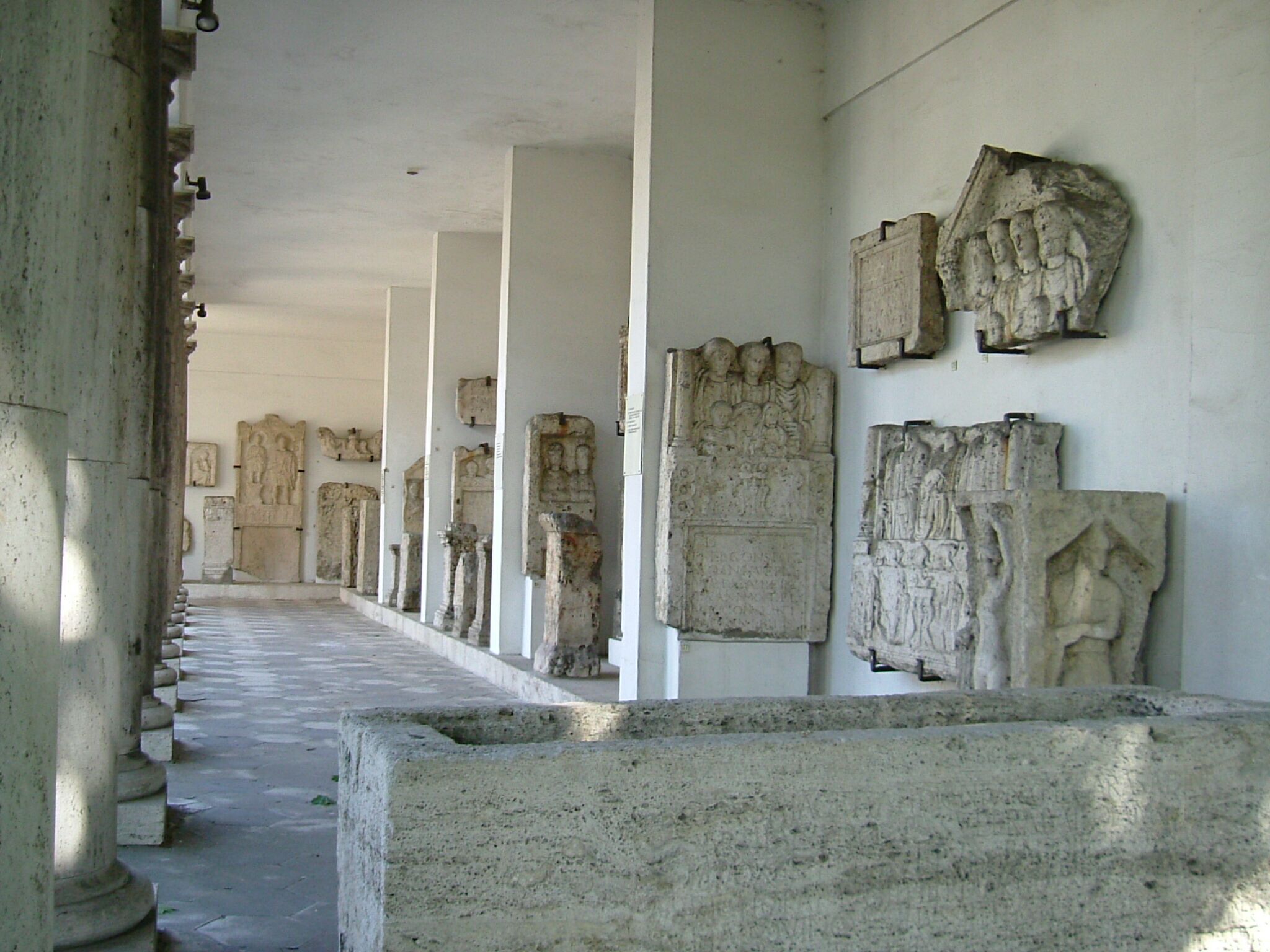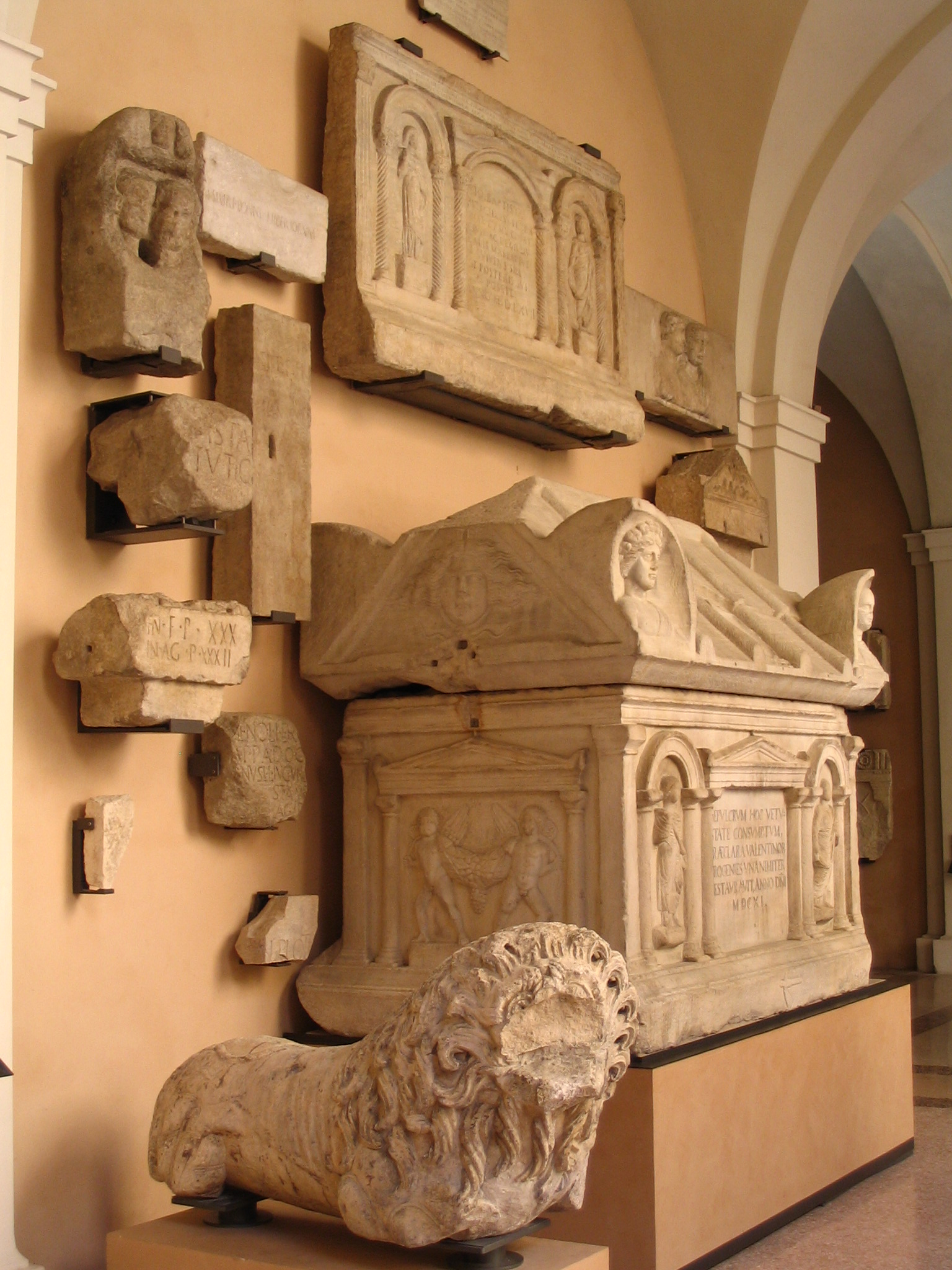|
Lapidarium
A lapidarium is a place where stone (Latin: ) monuments and fragments of archaeological interest are exhibited. They can include stone epigraphs; statues; architectural elements such as columns, cornices, and acroterions; bas reliefs, tombstones; and sarcophagi. Such collections are often displayed in the outdoor courtyards of archaeology museums and history museums. A lapidary museum could either be a lapidarium or – less often – a gem museum (e.g. the Mineral and Lapidary Museum, North Carolina). Examples * The Lapidarium (in the National Museum), Prague, Czechia * The Lapidarium, Kerch, Crimea * The Lapidarium of Kings, Copenhagen, Denmark * The (museum-lapidarium of Maffei), Verona, Italy * The Lapidary Museum, Avignon, France * The Estense Lapidary Museum, Modena, Italy * Split Archaeological Museum See also * A glyptotheque A glyptotheque is a collection of sculptures. It is part of the name of several museums and art galleries. The designation gl ... [...More Info...] [...Related Items...] OR: [Wikipedia] [Google] [Baidu] |
Lapidarium, Prague
The Lapidarium is a lapidarium and a part of the National Museum in Prague, Czech Republic. It is the largest permanent exhibition of historical collections of stone sculpture, tombs and architectonical fragments originating from Bohemia, mostly from Prague. History In 1839, František Palacký, an early supporter of the National Museum, advocated for collecting stone monuments and artifacts. In 1898, the precursor to the Lapidarium, the Exhibition of Monuments of Old Architecture and Exhibition of Architecture and Engineering, was held at the Výstaviště Praha. The exhibition's building was designed by architect Antonín Wiehl for the 1891 world's fair held in Prague and continues to house the museum today. The first permanent exhibition in the Lapidarium was held in 1905. The museum closed from 1914 to 1932 due to World War I. The museum again closed from 1939 to 1954 because of World War II. The museum closed from 1967 to 1993 for renovations. The Lapidarium ho ... [...More Info...] [...Related Items...] OR: [Wikipedia] [Google] [Baidu] |
The Lapidarium Of Kings
The Lapidarium of Kings (''Kongernes Lapidarium'') is a lapidarium in Copenhagen, Denmark. It exhibits a royal collection of sculptures, natural stone figures and plaster models. The museum is situated in the 400 year old brewhouse of King Christian IV. During the years leading up to 2013, the Board of the Palace and Culture Agency (''Styrelsen for Slotte & Kulturejendomme''), with the support of TrygFonden, implemented a fire protection of the 8,000-storey square meter brew house, to enable the building to be opened to the public. Lapidarium was officially opened on June 3, 2014. The collection consists of 300 statues, sculptures and ornamentation in different materials gathered from royal gardens, palaces and buildings. Among the treasures are a model of the equestrian statue of King Frederick V at Amalienborg, and the original equestrian statue of Christian V at Kongens Nytorv Kongens Nytorv ( lit. "The King's New Square") is a public square in Copenhagen, Denmark, c ... [...More Info...] [...Related Items...] OR: [Wikipedia] [Google] [Baidu] |
Lapidarium, Kerch
The Lapidarium is a lapidarium in Kerch, Crimea. It has a collection of samples of ancient art, containing items found during the excavation of the ancient Bosporan kingdom and other finds discovered on the territory of the Kerch peninsula. It occupies one of leading places among the repositories of classical epigraphic monuments in the world. Lapidarium are stored in the Kerch Bosporan Greek inscriptions made in stone, sculpture and architectural details, samples, gebraistskih and Turkish gravestones. It is open to the public on weekdays and weekends from 10:00 up to 16:00 local time, and is closed Mondays. History of establishment The lapidary collection compiled materials from the personal collection of famous Explorer Paul Du Brux, who in 1810-1820s put together a collection of antique items and gave it the name "Drevnehraniliŝe". Later the collection was supplemented from different sources. Most of the collection was formed in the period leading up to 1917. Some instances ... [...More Info...] [...Related Items...] OR: [Wikipedia] [Google] [Baidu] |
Kerch
Kerch ( uk, Керч; russian: Керчь, ; Old East Slavic: Кърчевъ; Ancient Greek: , ''Pantikápaion''; Medieval Greek: ''Bosporos''; crh, , ; tr, Kerç) is a city of regional significance on the Kerch Peninsula in the east of the Crimea, Ukraine. Kerch has a population of about Founded 2,600 years ago as an ancient Greek colony, Kerch is considered to be one of the most ancient cities in Crimea. The city experienced rapid growth starting in the 1920s and was the site of a major battle during World War II. Today, it is one of the largest cities in Crimea and is among the republic's most important industrial, transport and tourist centres. History Ancient times Archeological digs at Mayak village near the city ascertained that the area had already been inhabited in 17th–15th centuries BC. While many finds from Kerch can be found in the Hermitage Museum in St Petersburg and the local museum, a large number of antique sculptures, reliefs, bronze and ... [...More Info...] [...Related Items...] OR: [Wikipedia] [Google] [Baidu] |
National Museum (Prague)
The National Museum (NM) (Czech: ''Národní muzeum'') is a Czech museum institution intended to systematically establish, prepare, and publicly exhibit natural scientific and historical collections. It was founded in 1818 by Kašpar Maria Šternberg. Historian František Palacký was also strongly involved in the foundation of the museum. The National Museum houses nearly 14 million items from the areas of natural history, history, arts, music and librarianship, which are located in dozens of museum buildings. The main building of the National Museum has been renovated in 2011–2019, and permanent exhibitions are gradually being opened from Spring 2020. Origins After the French Revolution, royal and private collections of art, science and culture were made available to the public. The beginnings of the museum can be seen as far back as 1796 when the private Society of Patriotic Friends of the Arts was founded by Count Casper Sternberk-Manderschied and a group of other prominen ... [...More Info...] [...Related Items...] OR: [Wikipedia] [Google] [Baidu] |
Glyptotheque
A glyptotheque is a collection of sculptures. It is part of the name of several museums and art galleries. The designation glyptotheque was coined by the librarian of King Ludwig I of Bavaria, derived from the Ancient Greek verb ''glyphein'' (γλύφειν), meaning "cut into stone". It was an allusion to the word pinacotheca (from πίναξ '' pinax'', "panel" or "painting"). ''Glypton'' (γλυπτόν) is the Greek word for a sculpture. Museums that today bear this name or cognates of it include: * Glyptothek, in Munich, Germany * Ny Carlsberg Glyptotek, in Copenhagen, Denmark * National Glyptotheque, in Athens, Greece * Gliptoteka, in Zagreb, Croatia See also * Lapidarium A lapidarium is a place where stone (Latin: ) monuments and fragments of archaeological interest are exhibited. They can include stone epigraphy, epigraphs; statues; architectural elements such as columns, cornices, and acroterions; bas reliefs ... Types of art museums and galleries History ... [...More Info...] [...Related Items...] OR: [Wikipedia] [Google] [Baidu] |
Split Archaeological Museum
The Split Archaeological Museum is the oldest museum in Croatia when it was established in 1820 by a decree of the Dalmatian government in Zadar. Some 150,000 artifacts cover prehistoric times, the period of Greek colonization of the Adriatic, Roman Provincial and Early Christian era to the early Middle Ages and the period of Croatian popular rulers. There is a collection of stone inscriptions from Salona and the collections of Graeco-Hellenistic ceramic objects, Roman glass, ancient clay lamps, bone, and metal articles, gems and coins. The museum is housed at Zrinsko-Frankopanska 25 in Split. There is also a branch building in Solin (Salona and Tusculum ) and two regional centres at Vid near Metković (Narona Collection), and on the island of Vis. The museum complex consists of a two-story main building with the exhibition halls on the ground floor and the museum library as well as study rooms on the 1st floor as well as a row of arcades surrounding the main building (for the ... [...More Info...] [...Related Items...] OR: [Wikipedia] [Google] [Baidu] |
Estense Lapidary Museum
The Estense Lapidary Museum is a lapidarium-museum in Modena, Italy, located around the interior quadrangle of the ''Palazzo dei Musei's'' ground floor. It is owned by the province of Modena and the Gallerie Estensi. As the first public museum to be commissioned by the Duke Francesco IV d'Este upon his re-entry into Modena in 1814, it stands as a symbol of the collaboration between church, state and nobility. It also marks a new direction for the city of Modena, one recognising its rich historical identity. History The museum was built around an initial nucleus of antique stone objects already present within the Estense collection, thanks to Alfonso II d'Este's Ferrarese antique-dealer and Renaissance humanist Cardinal Rodolfo Pio da Carpi, who harboured a collection of Roman bronze coins and marble sculptures. It was later enriched with archaeological remains from the provinces of Modena and Reggio Emilia. The museum was inaugurated in 1828 by Francesco IV, with the first c ... [...More Info...] [...Related Items...] OR: [Wikipedia] [Google] [Baidu] |
Lapidary Museum (Avignon)
The Lapidary Museum is a lapidarium-museum in Avignon, France. It has housed the classical Greek, Etruscan, Roman and Gallo-Roman sculptures and objects of the Calvet Museum since the 1980s. They are both run by the Fondation Calvet. As well as exhibiting the museum's core collections, it also mounts summer temporary exhibitions (e.g. "La diffusion des cultes égyptiens et alexandrins dans le monde romain à L'Égypte copte et l'Égypte musulmane" and "Le laraire d' Esprit Calvet"), conferences and networking events, particularly for scholars. The museum is based at 27 rue de la République in a 17th-century building, previously the chapel of the city's Jesuit College. It was begun in 1616, initially to plans by Étienne Martelange and then by François de Royers de la Valfenière from 1620 onwards. de la Valfenière raised the walls as far as the nave's main cornice. The building was made a monument historique on 21 June 1928. Collections As well as Etruria, classical Greece ... [...More Info...] [...Related Items...] OR: [Wikipedia] [Google] [Baidu] |
Francesco Scipione
Francesco Scipione Maffei (; 1 June 1675 – 11 February 1755) was a Italian writer and art critic, author of many articles and plays. An antiquarian with a humanist education whose publications on Etruscan antiquities stand as incunables of Etruscology, he engaged in running skirmishes in print with his rival in the field of antiquities, Antonio Francesco Gori. Early career Maffei was of the illustrious family that originated in Bologna; his brother was General Alessandro Maffei, whose memoirs he edited and published. He studied for five years in Parma, at the Jesuit College, and afterwards, from 1698, at Rome, where he became a member of the Accademia degli Arcadi; on his return to Verona he established a local ''Arcadia''. In 1703, he volunteered to fight for Bavaria in the War of Spanish Succession, and saw action in 1704 at the Battle of Schellenberg, near Donauwörth. His brother, Alessandro, was second in command at the battle. In 1709, he went to Padua, where he b ... [...More Info...] [...Related Items...] OR: [Wikipedia] [Google] [Baidu] |
Wien - Schottenstift, Lapidarium (Mausoleum)
en, Viennese , iso_code = AT-9 , registration_plate = W , postal_code_type = Postal code , postal_code = , timezone = CET , utc_offset = +1 , timezone_DST = CEST , utc_offset_DST = +2 , blank_name = Vehicle registration , blank_info = W , blank1_name = GDP , blank1_info = € 96.5 billion (2020) , blank2_name = GDP per capita , blank2_info = € 50,400 (2020) , blank_name_sec1 = HDI (2019) , blank_info_sec1 = 0.947 · 1st of 9 , blank3_name = Seats in the Federal Council , blank3_info = , blank_name_sec2 = GeoTLD , blank_info_sec2 = .wien , website = , footnotes = , image_blank_emblem = Wien logo.svg , blank_emblem_size = Vienna ( ; german: Wien ; bar, ... [...More Info...] [...Related Items...] OR: [Wikipedia] [Google] [Baidu] |






